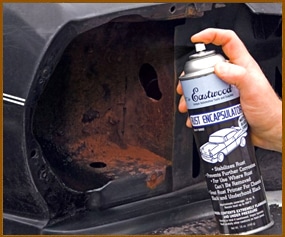
In this instance, you need a rust converter: a product which penetrates the rust and bonds with it, forming a new polymer compound altogether. This new compound will not only remove the current rust and often protect the metal from future rust, it will also generally serve as an effective base for further treatment.
Corroseal Water-Based Rust Converter Metal Primer 82331
Best Rust Converter on Today’s Market
Corroseal 82331 rust converter bonds deeper and firmer with the rust. While this requires less product to accomplish the task, it also protects the metal much better than the other products on our list.
In fact, Corroseal is the best rust converter we reviewed for using without another form of treatment and maintaining its protection. This product has been noted to protect from further rust by itself for well over a year.
Table of Contents
Top Rust Converters on the Market
Still, figuring out which rust converter is right for you can be difficult, made all the more so as each product offers a slightly different formula that can drastically affect the results. That is why we have put together a list of the 5 best rust converters and provided a buyer’s guide to help you make an informed choice.
| Image | Product | |
|---|---|---|
Editor's Choice 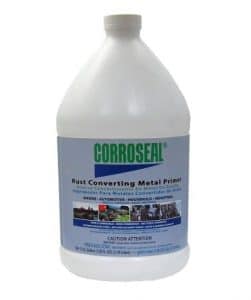 | Corroseal 82331
| Check Price |
Perfect Rust Remover 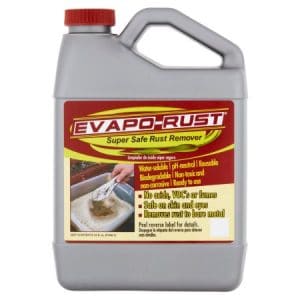 | Evapo-Rust ER012
| Check Price |
Easiest to Apply 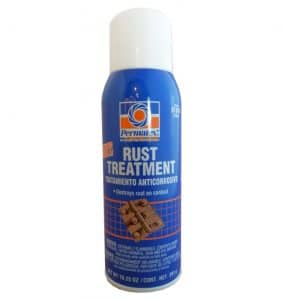 | Permatex 81849-12PK Rust Treatment
| Check Price |
Best Value 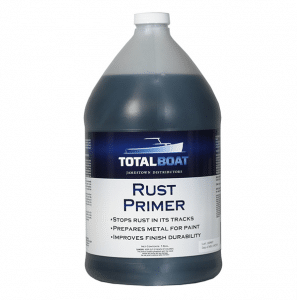 | TotalBoat Rust Primer
| Check Price |
Top Priming 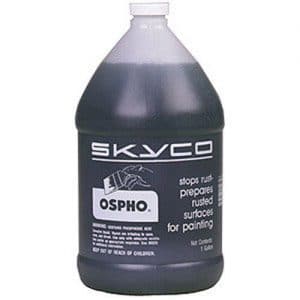 | Skyco Ospho Surface Prep
| Check Price |
1. Corroseal 82331 – Best Performing Rust Converter

One thing that makes Corroseal stand out about the other products is its viscosity. While TotalBoat and Skyco Ospho have a nearly identical viscosity, Corroseal is notably thicker–not to the point where it is impeded from being sprayed but still more than the other products on this list.
That thickness gives it a few advantages in terms of performance compared to the other products reviewed. First, the Corroseal will not need to be applied as much as the other rust converters. Often, you can get by with a single application–though, you will see even better results with two.
However, it is almost unheard of that you will need more than two application–even with medium rust projects. That is not a boast that either TotalBoat or Skyco Ospho can make, both of which generally require at least two applications and sometimes more depending on how corroded the project.
However, that performance often requires a better starting condition. While the Corroseal will work well with medium rusted metal, it still does not work as well with shingled metal. This is because the thicker rust converter does not as easily fit into the small area between the flaky rust. Thankfully, this is one of the easier cleanup as the only rust converter that washes out with just soap and water.
How To Paint Rusty Metal
- Acts as one of the better rust converting primers we reviewed
- Comes in a variety of bulk and individual sizes
- Easy cleanup with soap and water
- Prevents new rust without further treatment better than some other products on our list
- Does not come in its own aerosol spray can
- Fairly expensive compared to other products on our list
- Requires more thorough prep-work than some of the other products on our list
2. Evapo-Rust ER012 – Best Rust Remover

Evapo-Rust further differentiates itself even from other competing rust removers in that it does not utilize an acid based formula. This provides numerous benefits that acid based rust removers simply cannot compete with. For one, Evapo-Rust is one of the safest rust removing products available. It is non-toxic, non-flammable, and biodegradable.
While you likely would not want to do so, it is perfectly safe to dump remaining Evapo-Rust down the drain. However, the reason you would not want to dump the used Evapo-Rust down the drain has nothing to do with potential damage or risk to the drain.
Instead, you would simply be wasting a product that you could use again. Unlike many acid based rust remover and even some rust converters, you can mix used Evapo-Rust back with the remaining product without any negative effect. Whereas some acid based rust treatment product will activate once a used amount have been returned to the original, the Evapo-Rust formula does not suffer that same issue.
However, that is not to suggest that Evapo-Rust is without its faults. For one, Evapo-Rust provides no protection for the treated metals against future rust whatsoever. Granted, this should be rather apparent as the metal is not coated with a polymer but instead returns much closer to a brand new condition. Still, do not expect your metal treated Evapo-Rust to fare any better than it did before treatment.
Another issue with Evapo-Rust is that it takes the longest to work. If you are using Evapo-Rust on handheld items, this is less of an issue. However, many people turn to rust converters–and even rust removers–for larger projects, projects that cannot be fully submerged as the product suggests.
In this instance, you will need to regularly reapply and clean off the surface, or it will not work. This means a great deal more time, effort, and attention must be paid to this product than the other products on our list.
How to use Evapo-Rust
- Bio-Degradable and non-toxic
- The least expensive product on our list
- Leaves the metal looking new when cleaned off
- Can reuse leftover product
- Technically is a rust remover, not a rust converter
- Does not protect against future rust as well as other products
- Takes longer to work than most of other products on this list
3. Permatex 81849-12PK Rust Treatment – Easiest to Apply Rust Converter

The use of formic acid does have the advantage that it is less toxic than some of the other products on our list, though it is by no means non-toxic. Moreover, formic acid itself is less hazardous to people in general, including when it comes in contact with the skin or eyes.
For one, Permatex will not protect the treated metal without further treatments as well as many of its competitors. While many phosphoric acid based rust converters will serve for over a year without further treatment, an otherwise untreated Permatex piece of metal will be lucky to last six months.
Moreover, Permatex is not able to be applied to a project and then filtered out after use, returning the unused portion back with the rest. This will actually activate the remaining rust converter and decrease its quality.
- Comes in an aerosol spray can
- Acts as a super effective primer
- Dries much quicker than some of the other products on our list
- Less acidic than most other products on our list
- Not effective for preventing the formation of new rust without further treatment
- Does not come in large gallon sizes
- Not reusable like some of the products on our list
- Not as good for medium rust as some other products
4. TotalBoat Rust Primer – Best Value Rust Converter

Regardless, this means there are a few things you need to consider before choosing this product.
First, unlike the previous product, TotalBoat Rust Primer is indeed toxic. Moreover, the phosphoric acid base in TotalBoat Rust Primer is far more acidic than with Permatex. While you should definitely use protective gear with Permatex–especially protective eye gear–it is almost a necessity that you use protective gear with TotalBoat Rust Primer as getting it on your skin alone can cause inflammation and a burning sensation.
That being said, each phosphoric acid based rust converter still uses a slightly different formula which affects the various qualities of the product. While TotalBoat Rust Primer is fairly thin, it also covers more surface area than any other product on our list. Granted, you will likely need to apply multiple coats to your project, but you can still get up to 500 sq. ft. of coverage out of a single gallon on lightly rusted metal.
Unfortunately, this also means that TotalBoat Rust Primer has a much longer curing time than many of the other products on our list. Whereas some of the other rust converters can technically accept further treatment from paints or other low-reacting treatments shortly after applied, TotalBoat Rust Primer will require the entire curing time–between one to two days–before you should apply paint or any other treatment.
- 500 sq. ft. coverage per gallon is one of the best we reviewed
- Much quicker drying time than many products on our list
- Can be used on unrusted metal as a primer
- Is not non-toxic, VOC free, or biodegradable
- Not the best rust converter for priming
- Will require a bit more post treatment cleaning than some of the other products on our list
- Incredibly thin and may require multiple coats more often than competitors
5. Skyco Ospho Surface Prep – Best Priming Rust Converter

Moreover, unlike the TotalBoat, the Skyco Ospho is not especially effective at protecting the metal alone after application. In this regard, the Skyco Ospho is more akin to the Permatex rust converter, though it is still more effective than the formic acid based product. Still, Skyco Ospho hangs its hat on one thing and one thing alone: priming.
In this category, it is difficult to beat the Skyco Ospho. Assuming that the project is properly prepared – another issue with the Skyco Ospho – this rust converter will bond especially well with light or medium rusted metal. Moreover, once the Skyco Ospho has fully bonded, it will serve as a much better primer for further treatment, like pain and epoxies, than most of the other products on our list.
Unfortunately, time is the major investment sink with this product. This product easily takes as long to fully set as the TotalBoat, though it will often take even longer. Thankfully, you do not have to invest that time beforehand as the Skyco Ospho rust converter will work even if the project is not excessively pretreated ahead of time.
- Can be reused if filtered
- Provides a solid primer for paint
- Does not flake off after application
- Does not protect without other treatments as well as some other products on our list
- Is not non-toxic, VOC free, or biodegradable
- Only sold in a single size
- Takes longer to set than some of the other products on our list
Rust Converters – Buyer’s Guide
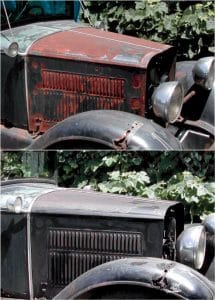
Instead, a rust converter should be used directly on rust and only rust. Keep in mind, this is not the same thing as tarnish, so silver, brass, copper, and other metals without iron in them are not proper uses for a rust converter. However, steel and other iron alloys will work just fine.
Finally, the degree of rusting is important, more so with some rust converters than others. Regardless, the ideal degree of rusting is medium to heavy. Keep in mind, if your project is heavily rusted, you will still need to sand or grind it somewhat smooth.
Application
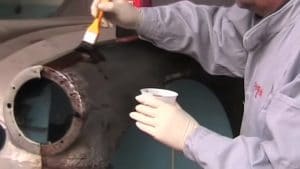
Keep in mind, while most rust converters can be painted on, different brands of rust converter will be more of less viscous than others. This presents distinct advantages and disadvantages for both. A thinner rust converter will spray much easier. If you are applying the rust converter to a long pole, it is far easier to spray it than to paint it.
However, thin rust converters run the risk of dripping if too much is applied. Moreover, thinner rust converters will often require more coats of application before all of the rust is converted for an especially corroded project.
Thicker rust converter has the opposite effect. It is far more difficult to spray from a bottle and will not work as well for this purpose. Conversely, a more viscous rust converter will better adhere to the surface and run less risk of dripping. It will also require fewer coats of thicker rust converters to treat the metal.
Drying Time
In truth, all rust converters should be allowed to dry for between 24 to 48 hours. However, depending on the brand’s formula, it is entirely possible that a rust converter can be painted over after only one to two hours of drying without any adverse effects to either the rust conversion, the priming action, or the paint adherence.
Depending on where you live, this may be more or less relevant. For instance, an automotive garage in the Southwest United States will not have any issues letting the rust converter cure for one or more days. On the other hand, a user in the Pacific Northwest and Caribbean Southeast may not be as fortunate, having to deal with rainy or humid conditions that can change in the span of an hour.
Cleanup
Depending on the active agent of the rust converter, cleanup can be a snap or require significant effort. Most rust converters are made from a phosphoric acid base that contains various other compounds to affect it different properties. These rust converters will often be the most difficult to clean.
Granted, the difficulty of cleaning any rust converter, even phosphoric acid based, will depend what you are cleaning it off of. For example, even the most difficult to clean rust converters will generally come off rather easy from a stone based driveway if you hose it down long enough.
Toxicity and Flammability
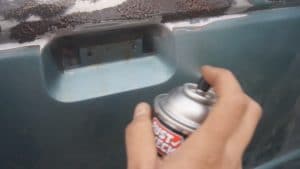
Keep in mind, this is not a nitric or sulfuric acid burn–you will not have to worry about scarring or blisters. However, direct contact with skin will often cause discomfort, irritation, and inflammation. As such, it is advised that you use a pair of gloves, often rubber, when applying a rust converter.
In terms of flammability, not all rust converters are equal. Some rust converters include additives that are specifically designed to make them non-flammable–including the ones with phosphoric acid as the active ingredient. However, aerosol rust converters are almost always flammable due to the compressed nature of the product.
Durability
Ideally, you will seal, paint, or otherwise treat the metal after you have applied the rust converter and it has cured. However, there are some brands out there that can hang their hat on the boast that their rust converter will protect against future corrosion absent any further treatment.
These products are few and far between and even they have their limits, but some of rust converters are essentially more durable than others.
Conclusion
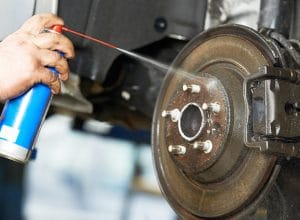
Speaking of primer, the Skyco Ospho may not provide the absolute best rust converting action, but it does serve as the best metal primer on our list–though that is the only category, outside of price, that the Ospho beat the Corroseal.
If you are looking for something a little less toxic, the Evapo-Rust is biodegradable, non-flammable, and non-toxic–though it is not actually a rust converter and cannot be used as a primer. Still, the Permatex uses a formic acid that, while not as effective as the phosphoric acid rust converters, serves as a good midway point between the Evapo-Rust and the other products on our list.
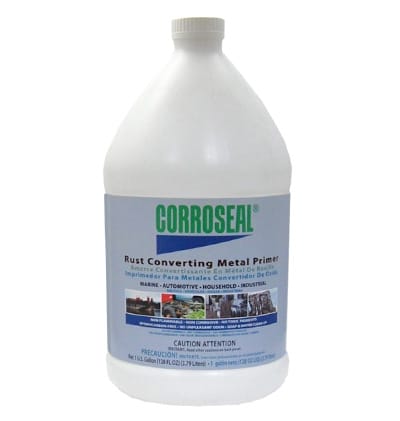
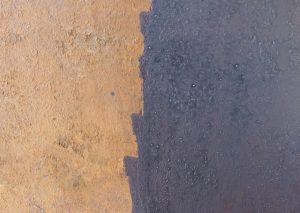
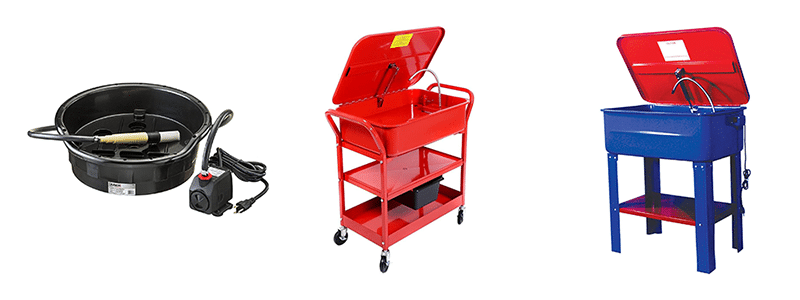
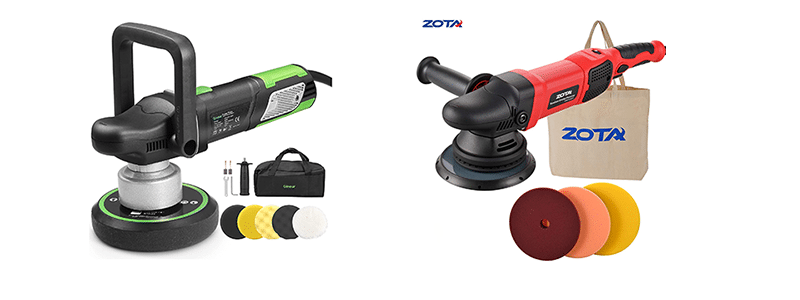
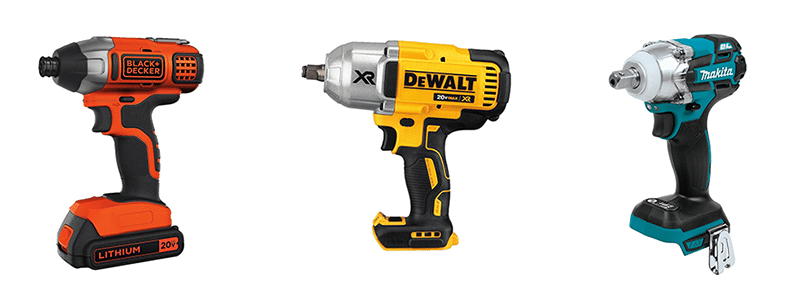
Any chance you could add GEM Rust Killer to the review of rust converters. Small company in Houston. Called them yesterday and the owner answered. Been using it for years. Good pricing too.
Balandis Chemical Co.
Houston, Texas
713-723-6524
Gemplers rust converter coating looks a lot like the Corroseal, it works great, can spray it, shoot it or brush it, comes out gloss black when it finds rust.
I note that Corroseal, which in my experience is very effective on rust alone, has some limitations. Namely it will not hold and neither will a top coat hold, if the rust converter is placed on a surface that has no rust. My truck box underbelly is a good example. I have some rust on the rails but only intermittently. Spraying a covering of Corroseal over the entire rails I am told, will not hold in those places where there was no rust.
Hence, I am leaning toward using phosphoric acid in areas with mixed rust and decent paint coating already in place. Then washing the acid off after it has cured, prior to then top coating the entire area.
Any suggestions for other contenders in areas not entirely covered by rust?
which product would be the best/easy for a metal mobile home roof with some rust on seams & rest is mostly light surface rust ? Is 95 model that has had no treatment as yet= am 65 y/o disabled live ( had back fusion in Oct /17 L-2 L-3 and have above knee amputation r/leg ) in rural area with little business for this type project. Any advice would be helpful as living on limited income in N.C, 27356
well done I like your ethics and your verbalization and points of comparison are logical, practical and prudent. thankyou for sharing your knowledge.
auto enthusiast of older Porsche and anything with powered wheels, from RC to Cars.
lloyd